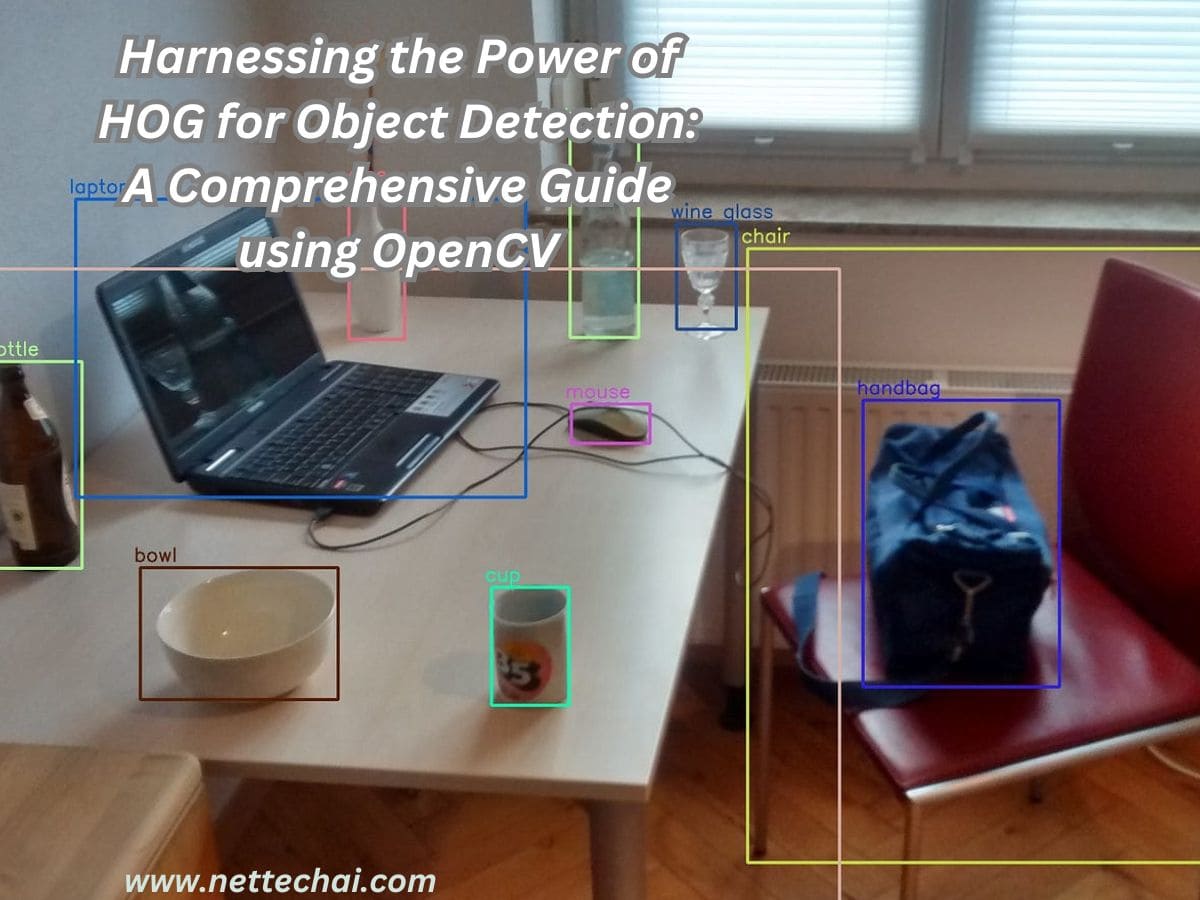Training an Object Detection Engine with HOG in OpenCV: A Comprehensive Guide

Overview
OpenCV object detection is a fundamental task in computer vision, and Histogram of Oriented Gradients (HOG) has proven to be a powerful feature descriptor for this purpose. In this guide, we will delve into the process of training an object detection engine using HOG in OpenCV. From understanding the basics of feature descriptors to the intricacies of calculating the HOG, we will cover each step comprehensively.
HOG for Classification
Before diving into the technicalities, it’s crucial to grasp the concept of HOG for classification. HOG is a feature descriptor that captures the distribution of gradient orientations in an image. This information is then used to represent the structure and texture of an object, making it an effective tool for object detection and classification.
Preparing Data
The success of any machine learning model, including an OpenCV object detection engine, heavily depends on the quality and quantity of the training data. Learn about the importance of data preparation and techniques to ensure your dataset is suitable for training an accurate HOG-based classifier.
What is a Feature Descriptor?
To understand HOG, one must first comprehend the concept of a feature descriptor. This section will explore the role of feature descriptors in computer vision, providing a foundation for understanding how HOG fits into the broader landscape of image processing.
What is Histogram of Oriented Gradients?
Delve into the theoretical underpinnings of HOG. Understand why this feature descriptor is particularly well-suited for object detection tasks and its advantages over other techniques. Gain insights into the principles that make HOG a popular choice in image processing.
Introduction to the HOG Feature Descriptor
Get hands-on with HOG as we introduce the feature descriptor in the context of image processing. Learn about the key parameters and settings that influence the performance of HOG-based classifiers. Gain practical knowledge on how to implement HOG in OpenCV.
Process of Calculating the Histogram of Oriented Gradients (HOG)
In this detailed section, we will break down the step-by-step process of calculating the HOG for an image. From gradient computation to cell histograms and block normalization, each stage of the HOG calculation will be explained with clarity, ensuring a thorough understanding of the algorithm.
Training Classifier using HOG Features
Once the HOG features are extracted, the next step is training a classifier. This section will guide you through the process of using OpenCV to train a classifier based on the extracted HOG features. Understand the nuances of parameter tuning and model evaluation for optimal results.
Frequently Asked Questions
Address common queries related to HOG and OpenCV object detection. From the basic definition of HOG features to their application in Python, this FAQ section aims to clarify doubts that may arise during the learning process.
Q1. What is a histogram of oriented gradients feature?
A Histogram of Oriented Gradients (HOG) feature is a popular image processing technique used for object detection in computer vision. It is particularly effective for recognizing and extracting features from images based on their gradients, which represent the intensity and direction of pixel variations. The HOG feature extraction process involves dividing an image into small, overlapping cells and computing the gradients within each cell.
Subsequently, histograms of gradient orientations are constructed for these cells, capturing the distribution of gradient directions. These histograms are then normalized to enhance robustness against variations in lighting and contrast. The final feature vector is formed by concatenating these normalized histograms, providing a concise representation of the image’s structural information. HOG features are widely employed in object detection tasks, such as pedestrian detection, due to their ability to capture distinctive patterns and shapes in images.
Q2. What is HOG features in image processing?
Histogram of Oriented Gradients (HOG) is a feature descriptor widely used in computer vision and image processing for object detection. It was originally introduced by Navneet Dalal and Bill Triggs in 2005. HOG features are particularly popular in the context of pedestrian detection, but they can be applied to various object recognition tasks.
The main idea behind HOG is to capture the local intensity gradients or edge directions in an image. The feature extraction process involves the following steps:
- Gradient Computation: Compute the image gradients to capture the changes in intensity. This is often done using Sobel operators to obtain the gradient magnitude and direction for each pixel.
- Cell Division: Divide the image into small, non-overlapping cells. The gradient information within each cell is used to represent local texture information.
- Orientation Binning: Within each cell, create a histogram of gradient orientations. This involves quantizing the gradient directions into discrete bins and accumulating the gradient magnitudes in the corresponding bins.
- Block Normalization: Group adjacent cells into blocks. Normalization is applied to the histogram values within each block to enhance the robustness of the feature representation to changes in lighting and contrast.
- Descriptor Concatenation: Concatenate the normalized block histograms to form the final feature vector for the image region of interest.
The resulting HOG feature vector is a compact representation that captures the distribution of local gradient orientations and magnitudes. This makes it effective for detecting object boundaries and shapes, which is particularly useful in object recognition tasks.
HOG features have been widely adopted in combination with machine learning techniques, such as support vector machines (SVMs), for object detection in images. The HOG descriptor provides a meaningful representation of local image structure, enabling algorithms to discriminate between different objects based on their shape and texture characteristics.
Q3. What is HOG feature for image Python?
Histogram of Oriented Gradients (HOG) is a feature descriptor widely used in computer vision and image processing for object detection. It works by capturing the local gradient information in an image, which is crucial for identifying object shapes and structures. The HOG algorithm divides an image into small cells and calculates the gradient (intensity and direction of change) within each cell. These gradient values are then used to construct histograms of gradient orientations, capturing the dominant directions of edges or patterns in the image.
The histograms are further normalized to enhance the descriptor’s robustness to changes in lighting and contrast. The resulting feature vector represents the distribution of gradients in the image and is used as input for machine learning classifiers or other algorithms for object detection. In Python, popular libraries like OpenCV provide functions to compute HOG features, making it accessible for a wide range of computer vision applications, including pedestrian detection, facial recognition, and more.
Q4. What should the size of HOG features for opencv object detection?
Histogram of Oriented Gradients (HOG) is a feature descriptor widely used in computer vision and image processing for object detection. The size of HOG features is determined by several factors, including the image size, the cell size, block size, and the number of orientation bins. The process begins by dividing the image into small cells, typically of size 8×8 pixels.
For each cell, a histogram of gradient orientations is computed, representing the distribution of gradient directions within that cell. These histograms are then grouped into blocks, and normalization is applied to enhance the descriptor’s robustness to changes in lighting and contrast. The final feature vector is constructed by concatenating these normalized block histograms. The size of the HOG feature vector depends on the number of cells, blocks, and orientation bins used in the computation. In practice, the size can vary but is often several thousand elements long, capturing the local gradient information in a structured manner for subsequent object recognition tasks.
Further Reading
Explore additional resources to deepen your understanding of HOG and object detection. Recommended books and websites will provide valuable insights and practical tips for those looking to expand their knowledge beyond the scope of this guide.
Summary
Summarize the key takeaways from each section, reinforcing the importance of HOG in object detection. Emphasize the practical aspects of implementing HOG in OpenCV and the potential applications of this technique in real-world scenarios.
In conclusion, this comprehensive guide aims to equip you with the knowledge and skills needed to train an object detection engine using HOG in OpenCV. Whether you are a beginner exploring the world of computer vision or an experienced developer seeking to enhance your skill set, this guide provides a step-by-step roadmap for mastering the intricacies of HOG-based object detection.

